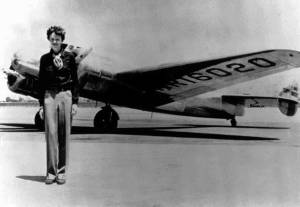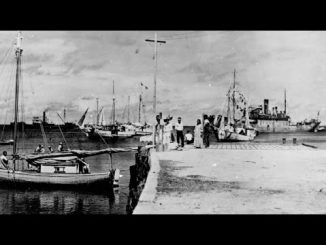Press Information:
“AMELIA EARHART MYSTERY”
Writer and Director: Carol Linn Dow
Original Story: Carol Linn Dow
Film from Jim Hayton interview: Richard (Dick) Spink… (dspink80@gmail.com)
Interviews & Film Marshall Islands: Richard (Dick) Spink… (dspink80@gmail.com)
Media: DVD and Television
Executive Producers: Felix Girard (fgirard@lostflightgroup.com) 888-909-0690 (toll free number)…. Carol Linn Dow (Beardov@aol.com) 972-758-2725 …Dick Spink 360-661-0084 (dspink80@gmail.com) … Jim Hayton 360-661-3302 (jim@northsoundaviation.com)
Copyright 2014 Carol Linn Dow. Registration WGAw #1740771
A plate and a dust shield that may change history
As Amelia Earhart and her navigator Fred Noonan circled the globe in 1937 on a tragic round-the-world flight, the record setting adventure suddenly ended at Howland Island in the wide expanses of the Pacific Ocean. Now, for the first time, the knowledge of what happened to Amelia Earhart may be about to change. Suddenly an explorer arrived on the scene. These discoveries invalidate the findings of the Tighar Group led by Ric Gillespie who believe Earhart’s airplane crashed at Gardner Island (Nikumaroro).
The question is the airplane can not be in two places at the same time. A large
percentage of the researchers who follow the Earhart loss (including Carol Dow) have never accepted the Gillespie findings as being true. Gillespie, as they believe, has to continuously come up with more and more exceptionally dubious evidence which they believe is false and misleading. Carol Dow stated, “Every time he sets out to find the airplane it fails. The answer seems to be that the Earhart airplane did not crash at Nikumaroro. It simply isn’t there.”
On a sales expedition selling aluminum boats from his factory in Bow, Washington, Richard (Dick) Spink picked up an Amelia Earhart trail at Milli Atoll in the Marshall Islands. After listening to countless stories from the Marshallese, Dick Spink enthusiastically shot film on the actual crash site, did four very important interviews with the people of the Marshall Islands, and enlisted the aid of a highly qualified aircraft accident examiner to verify the findings. The interviews are revolutionary especially the testimony of a Marshallese native, Shikaro Lajuan, who’s father and Jororro actually witnessed the crash of Earhart’s airplane on the reefs at Milli. Not only did they witness the crash, the natives of Milli Atoll took the two downed flyers to an adjacent island, Tokowa, and gave them food and water along with first aid for Fred Noonan’s infected leg. The story the natives tell is that the Japanese later arrived on the scene, and the two flyers were taken to a tramp steamer standing by offshore, the Koshu Maru. Subsequently, the airplane was winched off the reef and onto the rear of the ship where it was covered by a tarpaulin. Recently Ric Gillespie and the Tighar Group have been impressing the public with evidence from Gardner Island (renamed Nikumaroro). The problem is where did the airplane crash? Was it to the south of Howland at Nikumaroro or was it westbound at Milli Atoll in the Marshall Islands? The airplane can’t be in two places at the same time. Gillespie and his group do not have eye witnesses of the crash or natives who saw what happened after the crash that can backup their story. Carol Dow and Rick Gillespie have been friends for a long time, and they have both extended courtesies to each other in the search for Earhart evidence.
Explorer Dick Spink and book author and screenwriter Carol Dow teamed up to create a DVD entitled “Amelia Earhart Mystery” that they believe will have a lasting impression
on the Earhart story. There are indeed two artifacts that will shake up the Amelia Earhart world. The first item is a red highly eroded plate that at one time was painted red. The second item is, according to the testimony of an expert crash examiner, a dust shield that is part of a hub cap assembly off a Lockheed Model 10 Electra Airwheel. This undoubtedly places the scene of the crash of Earhart’s airplane at Milli Atoll, the Marshall Islands, they believe.
The red plate is the cover for an external plug-in for a jump start on an airplane engine. Starting big radial airplane engines places a tremendous drain on the battery system, and, if the batteries are down, the pilot of an airplane would be forced to call for a jump start with an APU (Auxiliary Power Unit also called a Ground Power Unit) . The red paint is a dead giveaway the plate came from Earhart’s airplane as the leading edges of the wing of Earhart’s airplane were painted a matching color of red. If you look closely at the plate you can see the aluminum wrinkles are at a 45 degree angle which is a characteristic of aviation aluminum under stress. It wrinkles. After the crash in Honolulu in the first attempt to circle the world, the APU plug was evidently moved to a spot in the red portion of the wing. The superstructure of the original installation would have been crushed by the impact of the crash. Consequently, the plug must have been altered and moved to safer spot under the wing. There is no other explanation for a red painted APU plate that was found on a deserted reef in the middle of the Pacific ocean.
In this picture the crushing of the area of the APU plate in the Honolulu crash can be clearly seen. It would have created damage to the internal superstructure. If you study this picture closely you should notice the smooth surface of Goodyear Airwheels with no treads. No treads means no directional traction. Thusly, it would have been easy to produce a ground loop with a heavy load of 1,100 gallons of aviation gasoline sloshing around. However, the bulk of the arguments of the crash were that Earhart attempted to alternate the power setting on the engines which caused the airplane to swerve and swing into a vicious loop.
There is no question this plate found at Milli Atoll came off an American airplane. It did not come off a Japanese airplane. It is an inspection plate. The paint primer the Japanese used in World War II had a high gloss finish, and it was sprayed on in multiple layers. The primer on this plate, as testified by expert witnesses, is zinc chromate which has an unmistakable yellowish-green-blue cast. It was developed by U.S. companies in the 1930s for use in painting airplanes. It is a 100% American product. The plate has three identifying factors: 1. Red paint from the painted areas of the Earhart wings.
2. The unmistakable 45 degree wrinkles of an airplane crash.
3. The undeniable zinc chromate primer on both sides of the plate.
To see the second artifact Dick Spink found you don’t have to go far. Look above the red APU plate lying on the reef, and you’ll see a strange looking round piece of aluminum in
the junk pile. On the first trip to Milli, Dick walked off and left this sparkling jewel behind. In this picture you are seeing where it was left as a discarded piece of junk. For
77 years it fooled a lot of people. What was it? It turned out to be the dust shield for a hub cap assembly on the landing gear of a Lockheed L-10. Dick Spink, on his second trip to Milli brought it back to Seattle and took it to an old time airplane mechanic who restores
vintage aircraft in his backyard airplane factory. Jim Hayton went “buggy,” as he would describe it, when he saw it. Instantly, he knew what it was.
This round piece of beat up metal was the dust cover off the hub cap assembly of a Goodyear Airwheel. It would have been the same make and model that was used on
Amelia Earhart’s Lockheed Electra. Stunned, Hayton could only come to one conclusion.
The airplane that crashed at Milli had Goodyear Airwheels. To say it was an amazing find is putting it mildly. There was only a handfull of airplanes in the whole world that
had balloon Airwheels. One of those airplanes had crashed at Milli Atoll. To top it off,
Jim Hayton and Dick Spink have located a parts manual for the Lockheed 10 series that shows the installation of the dust cover on the wheel hub. It is the same dust cover that was found at Milli Atoll.
A series of pictures showing the wheel hub,
the dust cover, and Jim Hayton at work in
his airplane factory. In the last picture the
dust cover is superimposed over the hub.
The story of the loss of Amelia Earhart has been hotly debated down through the years.
Several of the theories and the evidence that has been presented is on the crackpot side causing members of the press to cry out with words of “baloney.” Psychics have even come into the battle with mysterious incantations pronouncing knowledge and contact
with the spirit world. People claim they have seen the ghost of Amelia Earhart prowling around the Earhart homestead in Atchison, Kansas. According to members of the local population Atchison, it seems, is one of the most ghostly towns on the banks of the wide Missouri. Even so, the most popular and the most often used excuse explaining the disappearance of Amelia Earhart has been the theories dubbed with the title of “crashed and sank.” Carol would say, “they took the easiest way out. Plop, just drop her off in the ocean, and that’s the end of it. What a travesty of justice this is.”
According to Felix Girard, executive Producer of Mystery, “the discoveries in the Marshall Islands are new, they are exciting, and now for the first time the public has something they can really bite their teeth in. We originally thought the public
would bite into the post loss transmissions and Almon Gray’s Affidavit as it appears
in Carol Dow’s book, The Lost Flight of Amelia Earhart. Nonetheless, the current effort she is making appears to be even better yet. Perhaps now we really have the chance to boost the story of Amelia Earhart and the undisputable crash that took place at Milli Atoll in the Marshall Islands.”
Notes:
Amelia Earhart Mystery DVD can be purchased at AmeliaEarhartBook.com
Carol Dow can be reached at CarolLinnDow@aol.com


